

One to What? BYOD 4 Learning (PNWBOCES) Districts Tackle Questions Surrounding BYOT Policy. eSchool News » How to make BYOD work for your schools » Print. Posted By Laura Devaney On October 29, 2012 @ 1:41 pm In Featured Superintendent's Center,IT Management,Mobile and Handheld Technologies,One-to-one,Policy,Registration Required,Superintendent's Center,Top News | Comments Disabled One of the largest challenges in a BYOD initiative is meeting the needs of students who don’t own a mobile device, or who don’t have internet access at home.

The Contraband of Some Schools is The Disruptive Innovation of Others with BYOT (Bring Your Own Tech) While cities like the one where The Innovative Educator works view student owned devices as contraband, I have found one of the most exciting disruptions to traditional teaching practices to be extending to students the invitation to “Bring Your Own Technology” (BYOT).

Last year, Forsyth County Schools in Georgia modified their technology guidelines to do just that! They permitted students to bring their personal technology devices to school to assist in their learning. Forsyth County Schools has always pursued the use of technology to improve educational opportunities. The district’s vision for classroom technology after-all is “to engage students in asking questions and choosing tools to facilitate real world problem solving.”
Classrooms are each equipped with an interactive whiteboard, teacher laptop and four student desktop computers. Our Beginnings Forsyth County Schools began its venture by implementing a BYOT wifi network in every school. Fundamental Changes Going Viral. The Contraband of Some Schools is The Disruptive Innovation of Others with BYOT (Bring Your Own Tech) Ideas for Bringing Your Own Device (BYOD) Even If You Are Poor. Let the Learning Begin: Handheld Devices. 3…2…1…Happy New Year everyone!
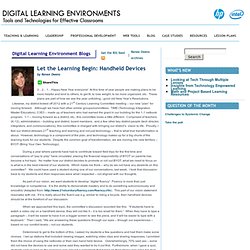
At this time of year people are making plans to be more helpful and kind to others, to get fit, to lose weight, to be more organized, etc. These plans are part of how we see the year unfolding - good old New Year’s Resolutions. Likewise, my district kicked off 2012 with a 21st Century Learning Committee meeting – our new “plan” for moving forward. Although we have had other similar groups/committees: TIME (Technology Integration Master Educators), C3E3 – made up of teachers who had earned the grant in our building for the 1-1 netbook program, 1-1 – moving forward as a district, etc., this committee looks a little different.
Comprised of teachers (K-12), administrators – building and district, board members, and a few other key district people (tech director, integrators, and communications), this committee is charged with bringing our district’s vision to life. BYOD - Bring your own device. 5 Ways to Make BYOD Work For Y. Across socioeconomic divides, students have more access to personal cell phones, tablets, and computers than ever before.

So why not harness the power of that technology in school? Whether your district has an established bring-your-own-device (BYOD) policy or whether you’re just beginning to explore the idea, here are some best practices for making BYOD a success. 1. Establish clear expectations. Bring Your Own Device Prompts School Infrastructure Investments. WASHINGTON, D.C. — Many of the nation's school districts still don't have the bandwidth needed to support mobile devices used by students.
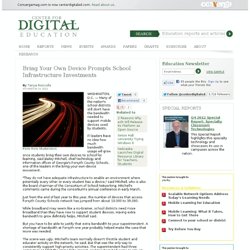
IT leaders have no idea how much bandwidth usage will grow once students bring their own devices to school for learning, said Bailey Mitchell, chief technology and information officer of Georgia's Forsyth County Schools, one of the leaders in the bring-your-own-device movement. "They do not have adequate infrastructure to enable an environment where potentially every other or every student has a device," said Mitchell, who is also the board chairman of the Consortium of School Networking. Mitchell's comments came during the consortium's annual conference in early March. Just from the end of last year to this year, the number of devices that access Forsyth County Schools network has jumped from about 10,000 to 19,000. Pros and Cons of Bringing Your Own Device to Work.
The concept of “bring your own device” (BYOD) is a growing trend for business IT.

There are a variety of benefits to allowing users to supply their own PCs and mobile devices, but there are also some concerns. Make sure you understand both in order to embrace BYOD with confidence. It used to be that IT departments drove technology, but that has changed dramatically in recent years. The consumerization of IT revolution -- sparked by the iPhone -- has shifted the IT culture so that the users are the ones getting the latest, cutting edge technologies first, and they want to bring those devices to work.
Benefits Businesses that embrace BYOD have some advantages over competitors. You might expect users to revolt against paying for the devices and technology they use at work. That brings us to the second significant benefit: worker satisfaction. There are two corollary advantages that come with BYOD as well. Netp2010. How to Bring Our Schools Out of the 20th Century. There's a dark little joke exchanged by educators with a dissident streak: Rip Van Winkle awakens in the 21st century after a hundred-year snooze and is, of course, utterly bewildered by what he sees.

Men and women dash about, talking to small metal devices pinned to their ears. Young people sit at home on sofas, moving miniature athletes around on electronic screens. Older folk defy death and disability with metronomes in their chests and with hips made of metal and plastic. Airports, hospitals, shopping malls--every place Rip goes just baffles him. But when he finally walks into a schoolroom, the old... Subscribe Now Get TIME the way you want it One Week Digital Pass — $4.99 Monthly Pay-As-You-Go DIGITAL ACCESS — $2.99 One Year ALL ACCESS — Just $30! 7 Questions on Bringing Your Own Device. Smartphones and mobile devices are changing the business world.
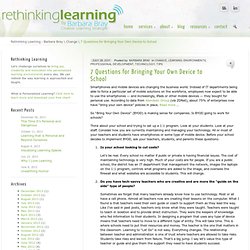
Instead of IT departments being able to force a particular set of mobile solutions on the workforce, employees now expect to be able to use the smartphones — and increasingly, iPads or other mobile devices — they bought for personal use. Go Wireless : Bring Your Own Device Initiative by Michael Walker on Prezi. BYOD to School? This fall, more schools than ever are allowing students to use their own laptops, iPads, and cell phones in the classroom.
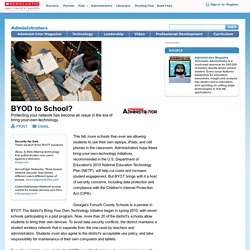
Administrators hope these bring-your-own-technology initiatives, recommended in the U.S. Department of Education's 2010 National Education Technology Plan (NETP), will help cut costs and increase student engagement. But BYOT brings with it a host of security concerns, including data protection and compliance with the Children's Internet Protection Act (CIPA). Georgia's Forsyth County Schools is a pioneer in BYOT. It is Time For Schools to Seriously Consider BYOT. This piece is cross-posted at the Huffington Post.As we continue to move even further into the 21st Century, technology becomes more embedded in all aspects of society.
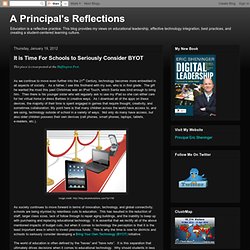
As a father, I see this firsthand with my son, who is in first grade. The gift he wanted the most this past Christmas was an iPod Touch, which Santa was kind enough to bring him. Then there is his younger sister who will regularly ask to use my iPad so she can either care for her virtual horse or dress Barbies in creative ways. As I download all of the apps on these devices, the majority of their time is spent engaged in games that require thought, creativity, and sometimes collaboration. My point here is that many children across the world have access to, and are using, technology outside of school in a variety of ways.
Image credit: